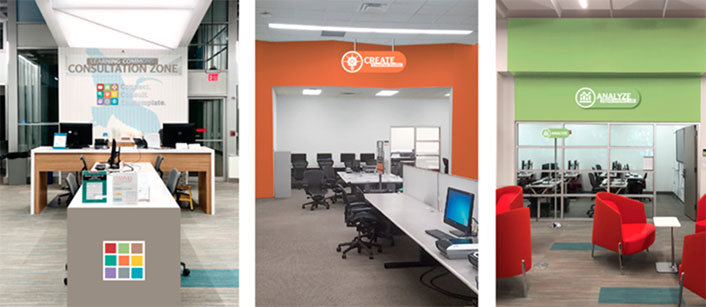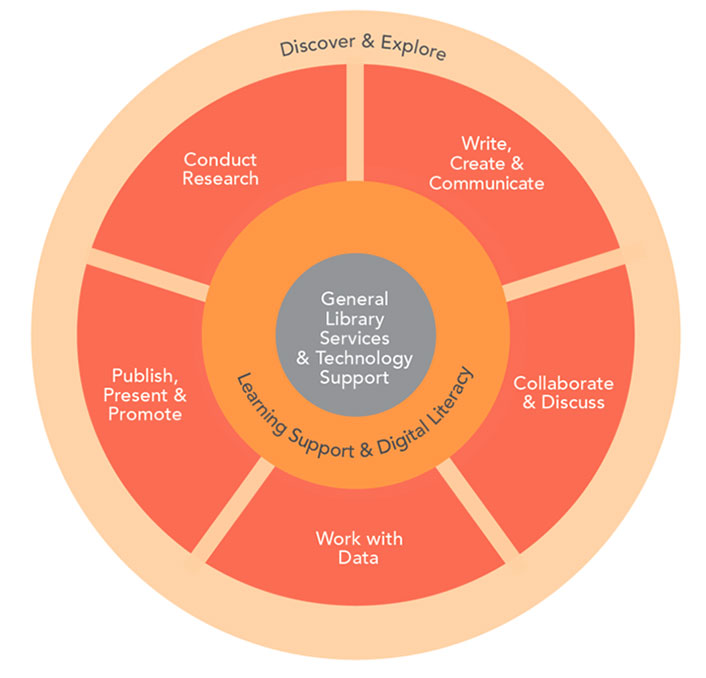How can institutions enable student success when students depend on support services that aren't seamlessly organized? The University of Miami answered this question by developing a new Learning Commons using design thinking.

In higher education, student success depends on the effectiveness of a wide variety of support services. These include getting help clarifying a paper's thesis, conducting research, visualizing data, working through a problem set, editing a video, honing presentation skills, selecting courses, finding a career path, and connecting with peers with shared interests, to name a few. The problem is that despite good intentions and hard work, the groups providing these services are often physically separated, report to different leaders, use different systems, have different success metrics, and would benefit from greater awareness of the whole student experience and the many support services students need.
So, how can institutions enable student success when students depend on support services that aren't seamlessly organized? The University of Miami answered this question by developing a new Learning Commons using design thinking to reimagine its services, staffing, and spaces. Planned with consultants from brightspot strategy, the project had to overcome challenges that many institutions face:
- We had bold new university leadership who set a high bar for student success.
- We had a project steering committee representing different facets of the university—library, technology, academic programs, and facilities—that had to find common ground despite differing points of view, historical approaches, and priorities.
- The demographics and needs of our students were changing rapidly.
- Our different service providers were separated physically, organizationally, and culturally.
What bound us together, however, was a shared commitment to student learning and growth.
To address these challenges, we designed the process to foster the development of collaborative teams that have now evolved into a community of practice among service providers. Leveraging design thinking was critical to this effort. We put people at the center of our process, rather than systems or policies. We solved problems through discussion and exercises, informed by quantitative analysis, creative insights, and a willingness to engage in difficult conversations. Our teams prototyped ideas to get feedback, learn, and improve (see figure 1).

Together with brightspot, we worked to assess the needs of students, benchmark against peers, create the vision, develop a shared service model across providers, test out new service concepts, communicate our ideas, and build consensus. None of this would have been possible without organizing ourselves for success by creating cross-functional working teams, as these represented not only the different service provider groups but a range of perspectives from the practical to the visionary (see figure 2).

Today, the Learning Commons supports students' learning through the co-location, coordination and enhancement of existing academic services. Complementing the classroom experience, the Learning Commons helps students of all disciplines in pursuing their own intellectual goals, in conversation with peers and experts and with access to scholarly and creative resources (see figure 3).

We look forward to sharing our process, tools, and lessons learned at the upcoming 2019 EDUCAUSE Learning Initiative Annual Meeting in Anaheim so that others can make progress at their institution. We will do this by telling our story, while offering opportunities to reflect and discuss along the way, so that participants can consider its relevance within the context of their own campuses.
First, we'll "flip the classroom" by making materials available in advance so that only minimal presentation is required. Second, we'll engage the audience through two short presentations—one on the "problem" and one on the "solution"—each followed by a poll and then a small-group discussion. This structure will enable participants to reflect on how the challenges in our case study relate to their institution (i.e., do they also envision better collaboration across groups?) and how the strategies and tactics we employed might be applied on their campus (i.e., could they use some of the tools we used, like service blueprints?)
This will give attendees the chance to identify student success challenges in the academic and administrative support services on their campuses, as well as the space and staffing challenges related to them. We'll also provide an opportunity to learn about and apply a design-thinking process to generate, test, assess, refine, and communicate solutions to these challenges. Perhaps most importantly, through small-group exchanges, participants can build relationships with like-minded change agents who are transforming how their institutions enable student success.
Beyond the process, tactics, and tools, we look forward to sharing our results and lessons learned with faculty and administrators who seek to simultaneously redesign their services, staffing, and spaces. Almost every day, we put into practice the design thinking mind-set, tools, and skills we learned on the project. We now have a bias toward testing and action rather than debating and critiquing. And instead of proceeding based on assumptions, we now strive to look at the data.
For us, perhaps the biggest change grew intentionally out of our planning process: we started as a group of disparate, disconnected service providers and today we work as a community of practice united in our commitment to learning and growth. Of course, it's still a work in progress—we still have conflicts, disagreements, and many different leaders—but on the ground we're functioning much more collaboratively and effectively for the good of our students.
We hope to see you in Anaheim!
Kelly Miller is Associate Dean for Learning and Research Services at the University of Miami.
Elliot Felix is the founder of brightspot.
Adam Griff is Director at brightspot.
© 2018 Kelly Elizabeth Miller, Elliot Felix, and Adam Griff. The text of this work is licensed under a Creative Commons BY-NC-SA 4.0 International License.
